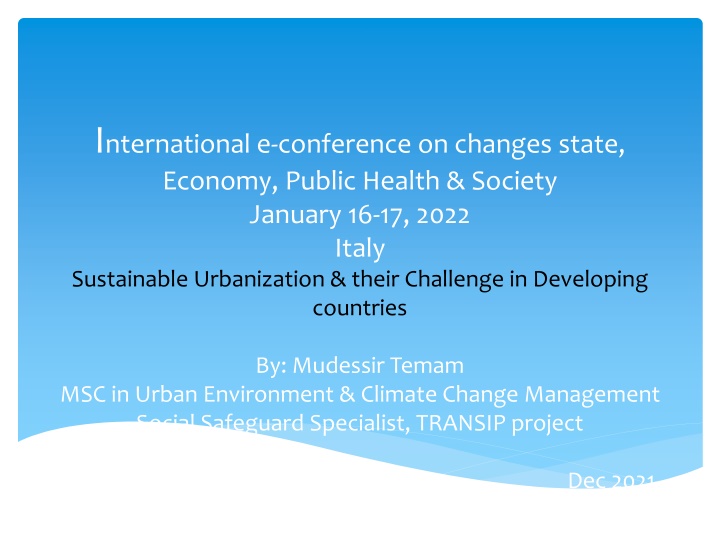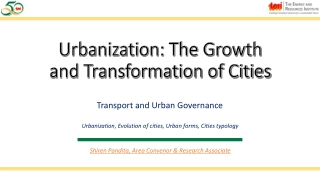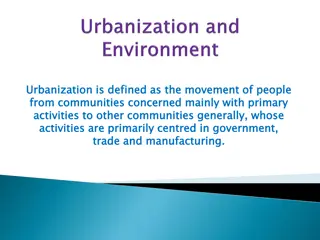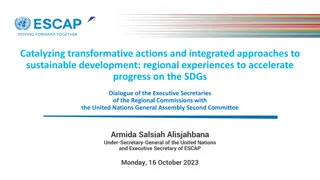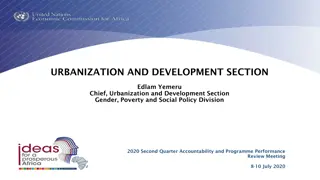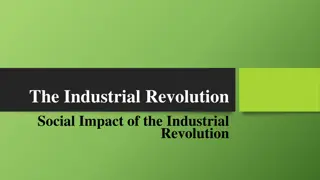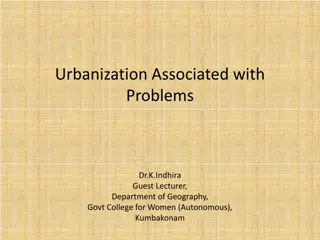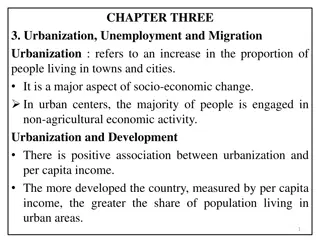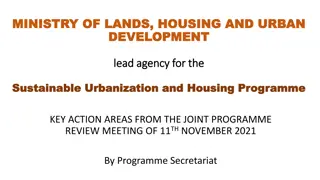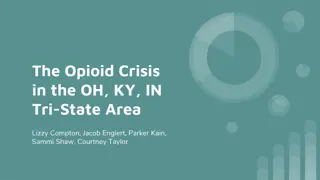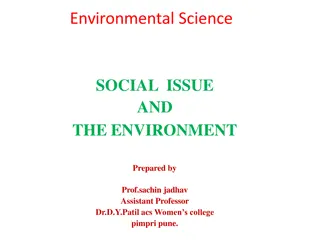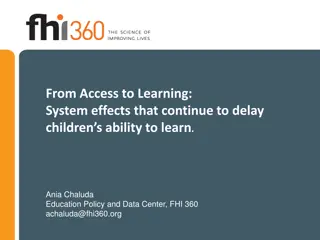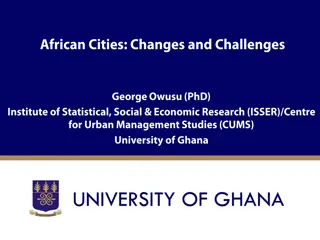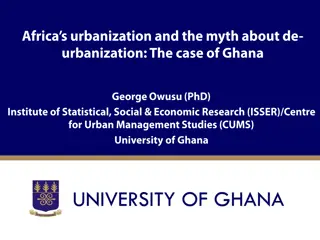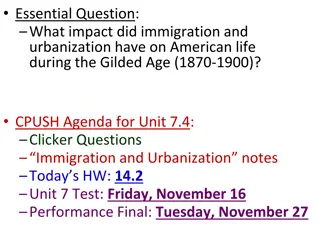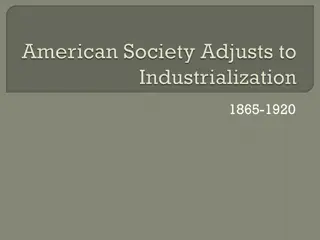Sustainable Urbanization Challenges in Developing Countries
Sustainable urbanism seeks to address real-world issues in urban planning and design amidst globalization, rapid population growth, economic fluctuations, increased energy demand, and climate change. The objective is to create livable, equitable, energy-efficient, ecologically sound, and prosperous urban environments for all residents.
Download Presentation

Please find below an Image/Link to download the presentation.
The content on the website is provided AS IS for your information and personal use only. It may not be sold, licensed, or shared on other websites without obtaining consent from the author.If you encounter any issues during the download, it is possible that the publisher has removed the file from their server.
You are allowed to download the files provided on this website for personal or commercial use, subject to the condition that they are used lawfully. All files are the property of their respective owners.
The content on the website is provided AS IS for your information and personal use only. It may not be sold, licensed, or shared on other websites without obtaining consent from the author.
E N D
Presentation Transcript
International e-conference on changes state, Economy, Public Health & Society January 16-17, 2022 Italy Sustainable Urbanization & their Challenge in Developing countries By: Mudessir Temam MSC in Urban Environment & Climate Change Management Social Safeguard Specialist, TRANSIP project D Dec 2021
Content Introduction Population Growth & prospect of developing countries Role of city in Urban Economy & the informal sector Urban Environment facility & their challenge Urban Infrastructure & equitable Social Services for sustainable Urban Development Urban governance & Administrative System Conclusion & Recommendations
Introduction Sustainable Urbanism is a new approach : For interdisciplinary planning and design of modern cities, Neighborhoods & Settlements. It explores sustainability and urban design in a rapidly urbanizing world by focusing on the processes that shape the form and function of the built environment in its:- full complexity infrastructures, land developments, built landscapes, and facilities that collectively make up urban center.
Introduction Cont`.. Sustainable urbanism need awareness and practice supported by skills and tools that needed to address real world problems in planning & designing our cities in times of :- Globalization, Rapid population growth, Economic fluctuations, Increased energy demand and Global climate change. Although, the aim of sustainable urbanism enhancing livelihood of all people in equitable and in better manner, creating sustainable urbanism in real world situation is more of theoretical than practical in implementing and sustaining urban development in good manner.
Objective Over all, objective and effort of sustainable urbanism:- Build better places more livable, More equitable & more energy efficient. Ecologically sound, and More prosperous for all people
Population Growth & Prospect of developing countries According to UN (2000) report
Continued In less developed countries level of population growth highly increase with average of 2.4 % per year during 2000-2030 and double in time of 29 years . However, level of urbanization is much lower than developed countries and estimated only about 40% reside in urban areas. On the other hand, this proportion much greater than that of 1950 (18%) and expected to increase of 56% by 2030 which similar to developed countries achieved in 1950.
Continued The level of urbanization distribution also high varied between developed and less developed countries. In 1950 Only 38% their population living in urban areas out three-quarter of 173 less developed countries. While, in more developed countries from half of 55 countries over 50 % their population reside in urban areas. By 2030, from three-quarter of all countries lived in less developed countries will be reached 49% and the more developed region will be attain 70% from three quarter of the countries. Over all ,when compare rate population growth of developing countries with developed region it is extremely increasing, however, level of urbanization still lagging behind and highly varied.
3. Role of city in Urban Economy and the informal sector The economic contribution of cities between 1960Sto late 1980s was not satisfactory .Urban economic growth faster since early 1980`s. Cities contribute some 60% of GDP in developing countries and are centers of:- Technological innovation, Social change, Rapid economic growth, and Growing concentration of poverty. Structural economic change of unstable market due to demand and supply composition affects cities economy. Cities have significant role in re-allocations of industrial capacity, creation of job and relative labour market, intensive local competitive production of market power .
3. Role of city Cont`. However, change of economic growth influenced by various social and political change .Inequalities and vulnerabilities also other major problem reflected in urban labour market . Developing countries, in the international level affected by:- Inflation, Economic, & Political risk, unless adopt policies of liberal and enhanced growth. Type of political system also challenges economic policy of National Governments with respect to global economy. Over all, cities are able to take their own initiative to promote the extension of their industrial capacity and to enhance competitive position
Continued Even though, cities are backbone for urban economy:- Poverty, Rapid economic restructuring, Complex socio political problem, and Global economy interference are affect most cities of developing countries so as to enhancing urban economic development in desired manner. In developing countries women share large proportion and high contribution in the informal sector economy. However, totally absent in formal economy activity. On the other hand, women`s contribution in labour force still increasing. Even if ,women s still smaller than men in industrialized market economy the contribution are 60 % and 31 % respectively , in organization for economic co-operation and development (OECD)countries.
Continued The trend of labour force participation rate of women between 1970 and 1990 rise in North Africa , west Asia , East Asia , and Latin America and the Caribbean, but declined slightly in other region . East Asia known by highest rate of economic activity of women estimated to 59% , while sub-Sharan Africa and South East Asia estimate with high average rate ranging from 45 to 50. In developing countries the informal sector is great role in urban economy development. However, majority of this sector not get legality from governmental body and especially women face challenge in getting equal opportunity in formal sector and marginalized at all.
3.1. Economic empowering and enhancing of locally economic development According to Jeremy et al.(2006) empowerment defined as `` the process of enhancing an individuals or groups capacity to make choices and to transform those choices in to desired actions and outcomes`` Empowerment positively associated with field of development including growth ,poverty alleviation ,and awareness of human rights . In other word, empowerment deals minimizing gap between those who have power and not. Empowerment also plays as instrumental role in improving development outcomes. In general, there are three principles for enhancing local private sector growth through integrated approach to local development namely:- Access to economic infrastructure and services; Strengthened human, social, and institutional capital; and Afavorable local business enabling environment.
3.1. Economic empowering Cont In most developing countries creation of jobs in cities not satisfy people participate in the urban labor force . The livelihood enhancement more focus on individual entrepreneurs and small scale enterprise participate in the formal labor work . While, majority people live in city are poor as a result number of informal sector extremely high which difficult to decline level of poverty in sustainable manner unless the poor households can generate income. In developing countries, economic empowerment and enhancement of local development not satisfactory due to less involvement of private sector and majority people economically not good and slum dwellers that not the capacity to have a choice .
3.2. Gender disaggregation in economy activity and social equity. According to ILO(2000), cited in UNDP (1994) Human development report great difference between men and women in respect to getting access to asset and social services. In developing countries, level of women`s literacy and years of schooling are much lower than men`s. Neglecting women`s from social services like health and nutrition is a serious problem especially in country like Asia and aggravated in Latin America where women`s neglected as a factor of age, employment, class ,education ,and economic sector which lead to inequality in income difference. Level and rate of open unemployment of especially African women`s always double than those of men and currently extremely going on. Women s limited access to employment opportunity especially in the formal sector and there is huge gap between women`s and men`s in open un employment rate .
3.2. Gender disaggregation cont` Although, female participation high in informal sector, women marginalized from wage employments. In other word absence of getting unfair position of employments, is a major challenge to boost sufficient and continues income generation. In general, women in developing countries are totally neglected from getting basic services. The gap between men and women extremely high in level of education, income equality, and poverty.
4. Urban Environment facility and their challenge 4.1 .Major Urban problems that Challenges sustainable developments In developing countries factors like push, pull and natural increase factor create over population and huge unemployment rate in cities which leads to poverty. Due to majority of peoples are poor and informal sectors which less contribution for tax revenue, providing basic services like house for people reside under slums and squatter settlements is major challenge for the city manager. On the other hand, transformation of transportation system from traditional to modern way, create un expected traffic problems and changing spatial pattern of city which enhance the need for transportation services and create isolation of home from place of work that significant problem in the city. Finally, environmental problem aggravated in less developed countries, due to poverty and absence of basic urban services as a result waste discharge from congested slum area and Industrial site inter in to river, coastal and underground area affect livelihood of poor people. Deforestation also common problem which facilitated near urban used of timber and domestic fuels In general, in less developed countries problems like poverty, in adequate housing, lack of urban services, transportation problems, and environmental degradation is one of major problem that affect urban sustainable development and great impact on life of majority of urban dwellers.
4. Urban Environment continued 4.2 Urban management tools for urban sustainable developments Urban management tools is a tool used to sustain urban development in good manner. Some of the instrument used to integrate environment with urban planning and management includes : Policy, Process , Planning and Management instrument .
4. Urban Environment continued Policy instruments serve as guiding principles for urban decision makers through information ,Voluntary, Economic and regulatory instrument. Process instruments deal with doing something through visioning, baseline studies and participatory approach. While planning instrument used variety of methods like environmental profile, Swot Analysis ,rapid ecological foot print assessment ,monitoring systems and indication and strategic environmental assessment which serve for urban plan development and implementation. Finally, management instruments provide tools to direct and administrative urban planning decision Cities Alliance(2007). In general to sustain urban development in proper manner adopting different urban management tools is very essential to build and create good urban environment in cities.
4. Urban Environment continued.. 4.3 Urban disaster and risk Management The consequence of environmental deterioration mostly affect the poor. Due to weak economic well being the poor often forced to built shelter in slum ,swamps or near polluting industries area without access to water and sanitation services . Poor people also participate in hazardous occupation with no health and safety legislation. Many cities of developing countries characterized by:- High rates of infant mortality, Limited life expectancy, Disability and work related injury, Disease, poor quality of life and mental health.
4. Urban Environment continued.. The environmental risk also linked with gendered and women directly affected by this problem and they have the capacity to promote change. Many cities in developing countries established in valley area which exposed to floods and related risk. Due to large number of poor people which live in congested and slum area providing basic services that decline disasters and risks is more challenging for governmental body. Therefore, to minimize the problem proper designing of urban disaster and risk management program is very essential to minimize the risk.
4. Urban Environment continued 4.4. Urban environmentally built environment Building urban environment require much capital and cost than agricultural development .In other word land more valuable when converted from agricultural to urban uses. In the process of urban built environment there are three distinctive circuit of capital accumulation namely:- The primary which involve the industrial production of commodities , The secondary involves the production and realization sale into the market in exchange for many of the built environment . The third one concerned with the reproduction of the labor power. Overall production of commodities under capitalism involve joined combination of factor of land ,capital and labor .However, in the production of built environment the land element is incorporated in to the product which is fixed in a particular place. In general, to built urban environment availability of capital and spacing is very crucial in cities and over all urban land more require capital than rural area.
5. Urban infrastructure and equitable social services for sustainable urban development 5.1 Access to land and housing services Tenure security is serving as protective right against unlawful evictions. However, majority of urban land encroached in informal way which have not legal right to get certificate from governmental body. The majority of this settlers are poor people which live in slum area that not capacity to built civilized house as a result exposed to eviction. On the other side, getting housing services also major problem in urban center . Housing services intimate relation with access to land, unless an individual right to get access to land, no opportunity to built house and simply relay on house rent. In contrary, building urban housing services require huge many which majority urban poor people not the capacity to built and purchase respectable house rather only wealth society benefited. Although tenure security serve as guaranty , majority of poor people and vulnerable groups live in cities of developing countries no opportunity of getting access to land and housing services.
5. Urban infrastructure Continued 5.2Access to basic infrastructure and services Provision of basic services include clean water, sanitation, waste management ,social welfare ,transport and communications facilities, energy ,health and emergency services, school ,public safety ,and free open space management facility . Absence of this basic services especially a key factor for poor people living in urban areas. In service provision, local provincial authorities they have responsibility to deliver services regulated by appropriate legislation and standards. However, management capacity, operational and maintenance of infrastructure and basic services are supported by central government .In addition, private sector and non-governmental organization that high contribution in service provision not inter linked with governmental coordination at the appropriate levels. In cities of developing countries, service provision not decentralized at local level in proper manner and only central government plays great role in maintenance and service provision . Ignorance of private sector and non-governmental organization from service provision also another major problem in service provision system.
6 .Urban governance and Administrative system 6.1 Good governance and Decentralization Good governance plays great role:- To keep public interest, Initiate urban technological innovation and Provide basic services . However, performance of decentralization in developing countries not so much effective and challenged by corruption and budgetary problem. Decentralization is an institutional arrangement that brings participation and local decision making process which supported by Legislations. Decentralization also help for planning procedure and specifies the level the responsibility to put it.
6 .Urban governance cont`.. New legal frameworks are developed through decentralization policies, by giving more responsibility at the local level or by assigning more responsible authority that deal with specific urban problems. However, process of implementing urban development project is frequently influenced by national political and economic circumstances in a particular country. Well managed good governance and decentralization system is welfare of especially for poor people. However, the way this system run in developing countries not good and majority of poor people not get opportunity ,the system rather complicated by economic and political system.
6 .Urban governance continued 6.2 Urban environmental degradation coping strategy Most cities of developing countries not established in well position and large number of people live slum area which exposed to environmental degradation. resilience to climate change in urban areas of developed countries. Based on conduct of a network researcher 15 cities of Africa and Asia vulnerable and The research indicate that flooding ,water availability and changing patterns of disease are among serious problems of climate change in urban center. Besides, institutional set up also equivalent factor in determining vulnerability and facilitating resilience. Building resilience strongly depend on the quality of local knowledge, capacity and willingness to act. Urban resilience also strengthens by adoption of proper strategies and strong economic base to cope the shocks and stress of climate change. As a result of high climate variability in cities of developing countries and poor people which exposed to environmental risk, building urban resilience is very essential by improving urban infrastructure, good governance, and increasing the capacity of individual and communities.
6 .Urban governance continued. 6.3 Integrated urban services planning, programming and delivery To improving the quality of urban service:- Provision involvement of private sector, Specificity, Gain experience of small projects , Analyze existing experience , & Bench marking in measuring performance are crucial for improving urban quality. The sense of privatization in the broad tem is empowering participation of private sector in service provision without necessarily changing the ownership utility and in narrow sense changing ownership by selling the share. In specificity scheme to provide urban services having detailed knowledge of specific sector and experience is very essential . Adopting experience of small scale service delivery improvement tested project applied by countries like chine`s, taken as best practice approach for other developing countries .
6 .Urban governance continued. In urban service provision performing of advantage of comparative analysis also helps to gain insights, to identify factors in specific and more general way. Finally, taking bench marking as a measure of performance tool help for comparing companies or utilities on a number of key indicator. Therefore, monitoring the performance and bench marking are good ways to assess the result. In general, for improving urban quality, usage of different tool and implementation approach is very crucial to provide integrated urban services provision system.
6 .Urban governance continued 6.4 Participation of local communities in urban policy making and implementation Participation of local community in policy making and implementation activity helps to give more attention for internal opportunity of development. A citizen a stronger voice in urban policy making and implementation activity, if only associated with importance of local context of development in participatory approach. can help public policy implementation more efficient and responsive to the needs of the community. Supporting of resident participation of both men and women in legitimize policy making The greater involvement of urban residents through participation is becoming more common in urban planning. To speed up local development in sustainable manner, giving chance and participating local community in policy and strategies is very essential to empower and to give specific needs.
Conclusion Sustainable urbanism is a new approach for interdisciplinary planning and design of modern cities, neighborhoods and settlements. Over all objectives to build better places of more livable and equitable in all aspect for all people. In developing countries, rate population growth extremely increasing time to time, while level of urbanization moving in slow manner. developing countries where majority of people are poor and informal sector. Economic empowerment and enhancement of local development also less common in Problems like poverty, in adequate housing, lack of urban services, transportation problems, and environmental degradation is one of major problem that affect urban sustainable development.
Recommendations Therefore, to sustain urban development in proper manner :- Proper policies and strategies that consider poor people must be designed, Women must be empowered in getting basic service like education , health and employment equally with men, Involvement of private sector and nongovernmental organization also must be strengthen to provide urban service provision in effective manner ,and finally reliable good governance and decentralization system also must be established.
References Byrned,D.(2001) Understanding the Urban ,Houndmills, Basing Stocke ,Hampshire. Cities Alliance (2006) Guide to city Development strategies improving Urban performance ,page 3, 18 H street NW Washington D.C. Cities Alliance (2007) The benefit of Urban Environmental planning .Livable cities .Washington ,D.C ,USA. David ,D.(2009) Building Urban resilience in the least developed countries ,International Institute for Environment and development ,London ,Uk .page 1.(http://iopscience.iop.org/ 1755-1315/6/33/332001/pdf/1755-1315_6_33_332001.pdf)( accesses 20 /11/2011). Farr, D. (2007) Sustainable Urbanism and Green Metropolitan City Regions .Available online at (http://www.kth.se/student/kurser/kurs/AG2147?l=en_UK)( accessed 26/12/2011). ILO (2000)Trends Issues and Approaches: An over view .Modular package on Gender ,Poverty and Employment. Reader Kit .International labour office ,Geneva ,Switzerland. Jeremy,H.,Beltelsen ,M. and Alsop, R.(2006)Empowerment in practice from Analysis to implementation .Directions in development .The world Bank .Washington ,Dc. USA. Lous ,H.,Rodrigo,S. and David ,W.(2005) Linking community Empowerment ,Decentralized Governance ,and public services provision through a local Development frame .Page 15,25 (http://siteresources.worldbank.org/INTCDD/5440901138724740952/20802848/decnetralization05.pdf) ( accessed 14/12/2011). Meine ,P.(2006) Managing cities in developing countries .The theory and practice of Urban Management .Professor of Urban Management in Emerging Economics Erasmus University Rotterdam, professor of water services management UNESCO-IHE, Delft, Affiliate professor of Urban Management at the Institute of social studies ,The Hague .Published by Elgar publishing limited ,Cheltenham,UK. Paul ,L. and Linda, M.(2005) An introduction to urban Geography .University distinguish professor and dean ,college of Architecture and urban studies ,Virginia Tech.Associate professor department of Geography University of Wisconsin Milwaukee, Upper saddle River,Newjersy. Robert,B. and Sally ,L.(1998) The city in developing world .Published by Addison wisely Longman ,Edinbourgh Gate ,Harlow ,England. United Nations center for human settlements (Habitate)(1996).Thehuman settlements conditions of the world`s urban poor ,Nairobi. United Nations(2002) World Urbanization prospects .Department of Economic and Social Affairs population division .The 2001 Revision .New York. United nations Human settlements program(2002) The Istanbul declaration and The Habitat Agenda with subject index Istanbul , page 56 ,Turkey,3-14 June 1996 .Nairobi.
